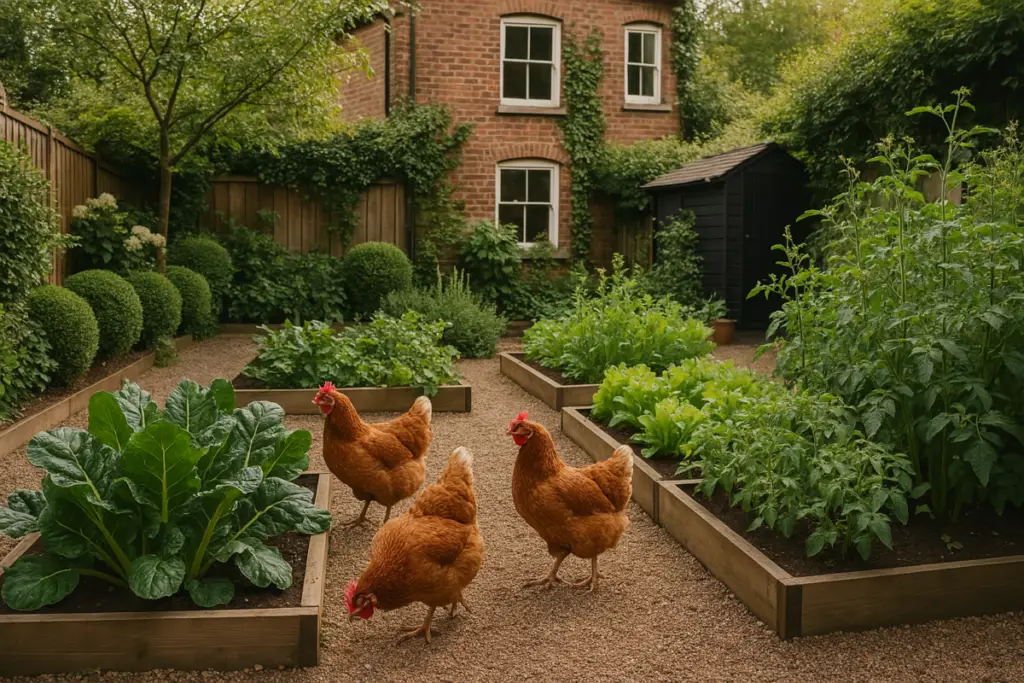
Introduction
Want backyard chickens without sacrificing your garden? It’s possible with the right approach!
Urban gardeners often dream of keeping small livestock like chickens, rabbits, or ducks in their backyard, imagining fresh eggs, natural fertilizer, and the satisfaction of a more self-sufficient lifestyle. But let’s be real—visions of hens happily pecking around lush vegetable beds can quickly turn into a nightmare if they start scratching up your seedlings or trampling your carefully cultivated greens.
The fear of plant destruction and limited space stops many urban homesteaders from taking the plunge. The good news? You don’t have to choose between your garden and a few happy, clucking companions. With a little planning and some smart strategies, you can create a harmonious space where your plants and animals thrive together.
In this guide, we’ll show you how to blend small livestock into your garden without sacrificing your hard work. From choosing the right animals to designing animal-friendly layouts, you’ll learn practical tips to make backyard farming with animals a success. Get ready to embrace a more sustainable, lively, and productive urban homestead!
Why Add Small Livestock to Your Garden?
Benefits Beyond Fresh Eggs and Meat
Adding small livestock to your urban garden brings more than just fresh eggs or occasional meat. Here’s why it’s worth considering:
- Natural Fertilizer: Chicken manure and rabbit droppings are nutrient-rich, boosting soil health when composted properly.
- Pest Control: Chickens and ducks naturally help reduce pests like slugs, beetles, and other garden nuisances.
- Soil Aeration: Animal movement lightly tills the soil, which can enhance drainage and aeration.
Urban Permaculture: Animals as Part of the Ecosystem
Integrating small livestock into your garden isn’t just practical—it’s also an essential part of urban permaculture. Think of your animals as active contributors to the ecosystem. Their waste becomes fertilizer, their foraging habits help control pests, and their natural behaviors support the garden’s biodiversity.
By thoughtfully incorporating livestock, you’re not just adding chores—you’re building a more resilient and interconnected urban homestead.
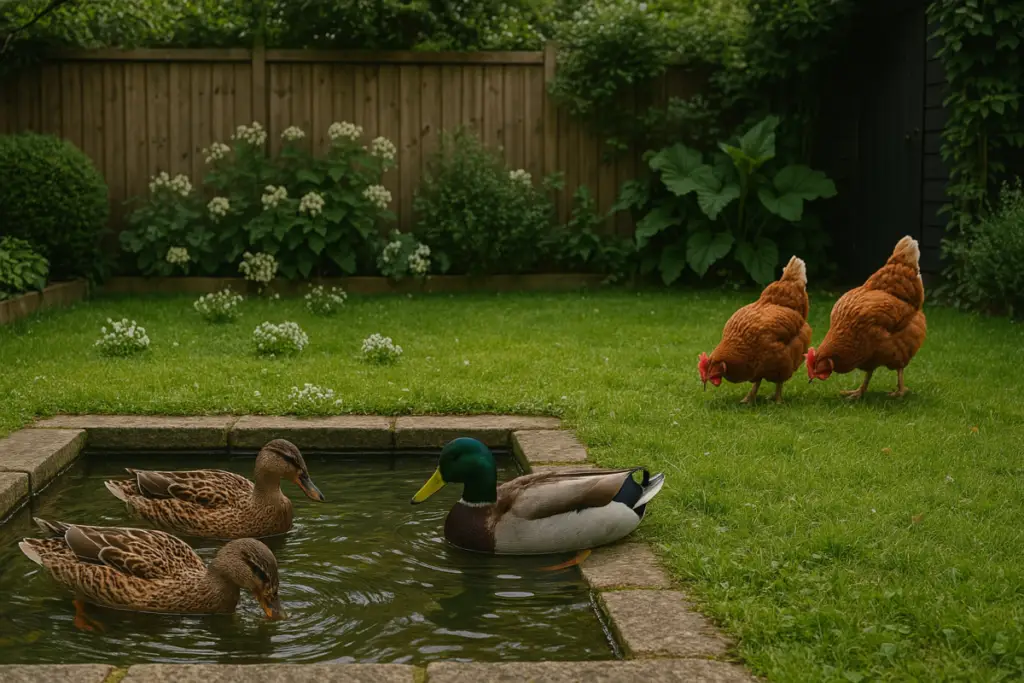
Choose the Right Livestock for Your Garden
Factors to Consider: Space, Noise, and Maintenance
Choosing the right livestock for your urban garden requires careful thought. Not all small animals are equally suited to tight spaces or residential areas. Here are some top contenders:
- Chickens: Great for eggs and pest control, but they can scratch up soil and be a bit noisy, especially roosters.
- Rabbits: Quiet, compact, and produce high-quality manure. Ideal for small spaces and less disruptive to plants.
- Ducks: Excellent for pest control and less likely to damage soil, but they require water access and can be messy.
Matching Animals to Your Garden’s Needs
Think about your garden’s size, the level of maintenance you’re comfortable with, and the types of tasks you’d like your animals to help with—whether it’s egg production, pest management, or soil improvement.
Creating a Garden-Friendly Animal Space
Designing the Layout
Creating a layout that works for both plants and livestock requires thoughtful zoning and separation. Use fencing, raised beds, and trellises to create distinct areas where animals can roam without causing damage.
- Separate Zones: Use low fences to keep chickens out of delicate garden beds while allowing access to less sensitive areas.
- Mobile Coops and Tractors: Moveable enclosures let you rotate grazing areas, preventing overgrazing and giving your garden time to recover.
- Vertical Planting: Use trellises to grow vining crops upward, keeping them safe from pecking chickens.
Mobile Coops and Tractor Designs
A great way to integrate animals without compromising your garden is by using mobile chicken tractors. These enclosures are designed to move around your yard, giving animals fresh forage while protecting your plants.
- Benefits:
- Reduced Soil Compaction: Regular movement prevents the ground from becoming hard-packed, allowing roots to breathe.
- Regrowth of Grazing Areas: Moving the tractor frequently lets grass and forage recover.
- Targeted Pest Control: Place the tractor in areas needing pest management to reduce insects naturally.
- Reduced Soil Compaction: Regular movement prevents the ground from becoming hard-packed, allowing roots to breathe.
- Tips for Effective Design:
- Lightweight and Sturdy Build: Opt for lightweight materials like PVC or aluminum to make moving the coop easy.
- Wheels and Handles: Adding wheels and ergonomic handles helps you maneuver the structure without hassle.
- Adequate Shelter: Incorporate a shaded area within the tractor to protect your chickens from sun and rain.
- Secure Flooring: Use wire mesh at the bottom to prevent digging predators while allowing chickens to peck at the ground.
- Lightweight and Sturdy Build: Opt for lightweight materials like PVC or aluminum to make moving the coop easy.
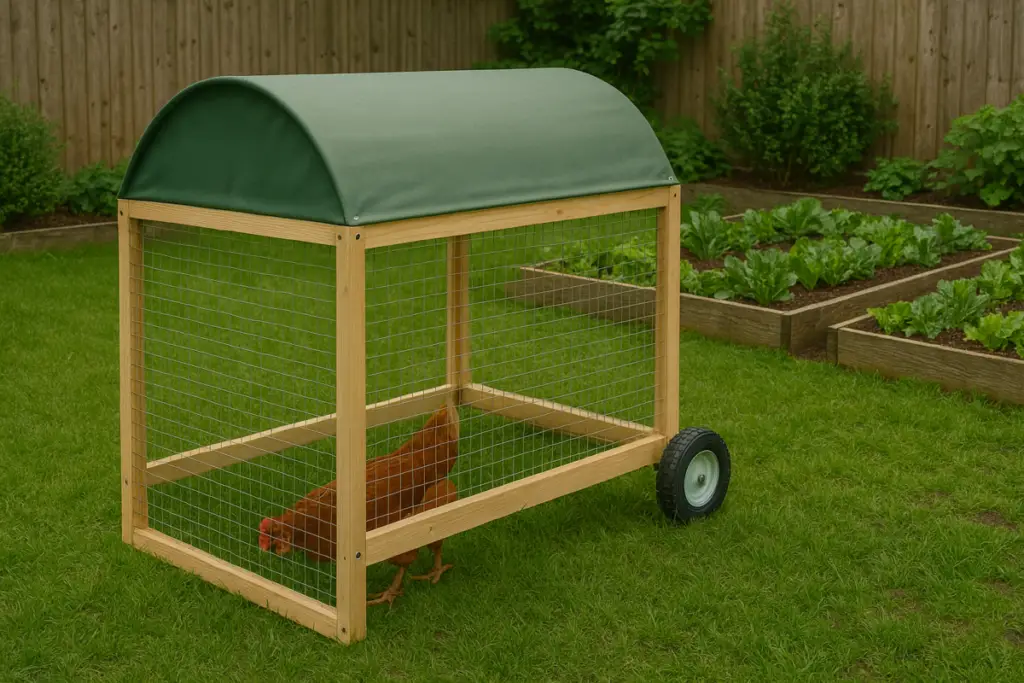
Protecting Your Plants from Livestock Damage
Natural Barriers and Fencing Solutions
One of the biggest challenges of integrating small livestock into your garden is protecting your plants from potential damage. Thankfully, there are practical solutions that allow for animal movement without sacrificing your greens.
- Raised Beds: Elevating your plants keeps them out of reach from most livestock while improving soil drainage and reducing compaction.
- Garden Walls: Low stone or brick walls add a rustic look while effectively keeping animals like chickens and rabbits away from delicate plants.
- Temporary Fencing: Lightweight, movable barriers can be positioned around vulnerable crops when livestock are grazing nearby.
- Netting: For areas prone to pecking, netting can be a simple and cost-effective way to keep plants safe.
Companion Planting for Livestock Tolerance
Certain hardy ground covers and companion plants can withstand light grazing or scratching, making them ideal for shared spaces.
- Clover: Hardy and nitrogen-fixing, clover tolerates trampling while providing forage.
- Thyme and Chamomile: Low-growing herbs that recover well from light foot traffic and can deter pests.
- Oregano and Mint: Spreads easily, withstands pecking, and has a strong scent that may deter digging.
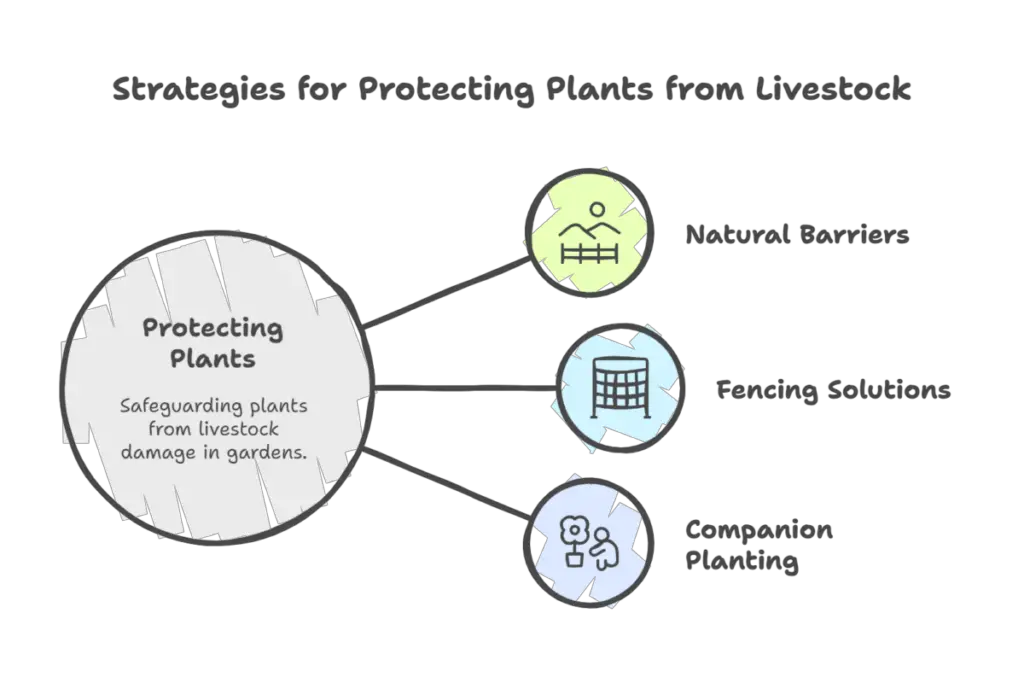
Feeding and Foraging: Make Use of Your Garden’s Abundance
Utilizing Garden Waste as Animal Feed
One of the great things about keeping small livestock in your urban garden is that your animals can benefit from garden byproducts. Rather than tossing vegetable scraps and trimmings, you can put them to good use as animal feed.
- Leafy Greens: Chickens and rabbits love spinach, kale, and other leafy greens that are past their prime.
- Vegetable Peelings: Carrot tops, beet greens, and potato peels can be safe and nutritious in moderation.
- Spent Plants: After harvesting, remove spent vegetable plants and allow animals to forage, reducing waste and cleaning up the garden.
Pro Tip: Always check the safety of certain scraps for your specific animals, as not all garden waste is animal-friendly.
Planting Forage Crops
Growing forage crops is a strategic way to keep your animals well-fed while enriching your garden soil. These crops not only provide nutrient-rich feed but also serve as cover crops when not in use.
- Alfalfa: High in protein and excellent for chickens and rabbits.
- Clover: Provides ground cover and is a favorite grazing option for many small livestock.
- Fodder Beets: A root crop that stores well and can be chopped for animal feed.
Creating a Forage Rotation Plan
To prevent overgrazing and maintain plant health, plan a forage rotation schedule. Divide your space into small paddocks or sections and rotate your animals between them. This gives plants time to recover, ensuring a sustainable grazing system.
Waste Management: Turning Manure into Gold
Composting Animal Waste Safely
Managing animal waste effectively is essential for maintaining a healthy urban garden. When composted properly, manure from small livestock can transform into a rich, organic soil amendment. Here’s how to do it right:
- Layering Manure: Combine animal waste with carbon-rich materials like straw, leaves, or wood chips. This balances nitrogen levels and helps with decomposition.
- Turning the Pile: Regularly turning the compost pile aerates it, speeding up the breakdown process and reducing odors.
- Curing Time: Allow the compost to age for several months before using it in garden beds. This ensures harmful pathogens break down.
Pro Tip: Never apply fresh manure directly to your plants—it can burn roots and potentially introduce pathogens.
Using Manure as a Soil Conditioner
Once fully composted, manure becomes an invaluable soil enhancer. It improves soil structure, boosts fertility, and aids moisture retention.
- Chicken Manure: High in nitrogen—great for leafy greens but should be well-composted to reduce acidity.
- Rabbit Manure: A “cold” manure that can be applied directly in small amounts, ideal for enriching garden beds.
- Duck Manure: Rich in phosphorus and good for flowering plants when composted.
Creating a Manure Composting System
Setting up an efficient manure composting system is essential for urban gardeners aiming to make the most of their small livestock waste. Here’s how to build and maintain a reliable setup:
- Location Matters: Choose a spot away from living areas and the main garden to minimize odor and potential contamination. Ideally, the site should have partial shade to regulate temperature.
- Bin or Heap? Use compost bins for a more controlled process or opt for enclosed heaps if you need to manage larger quantities. Both options help maintain heat and reduce odor.
- Layering Technique: Start with a base layer of coarse material (like straw or wood chips) to improve drainage. Alternate layers of manure, garden waste, and carbon-rich materials to create a balanced mix.
- Aeration: Build your compost pile with airflow in mind. Use vented bins or create air pockets by inserting PVC pipes vertically into the heap.
- Temperature Monitoring: Keep an eye on the internal temperature to ensure it stays between 130-150°F (55-65°C), the ideal range for pathogen breakdown.
- Moisture Control: The compost should feel like a damp sponge. Add water if it’s too dry or more carbon materials if it’s too wet.
Pro Tip: Set up a simple rain cover to prevent oversaturation during wet weather while maintaining good airflow.
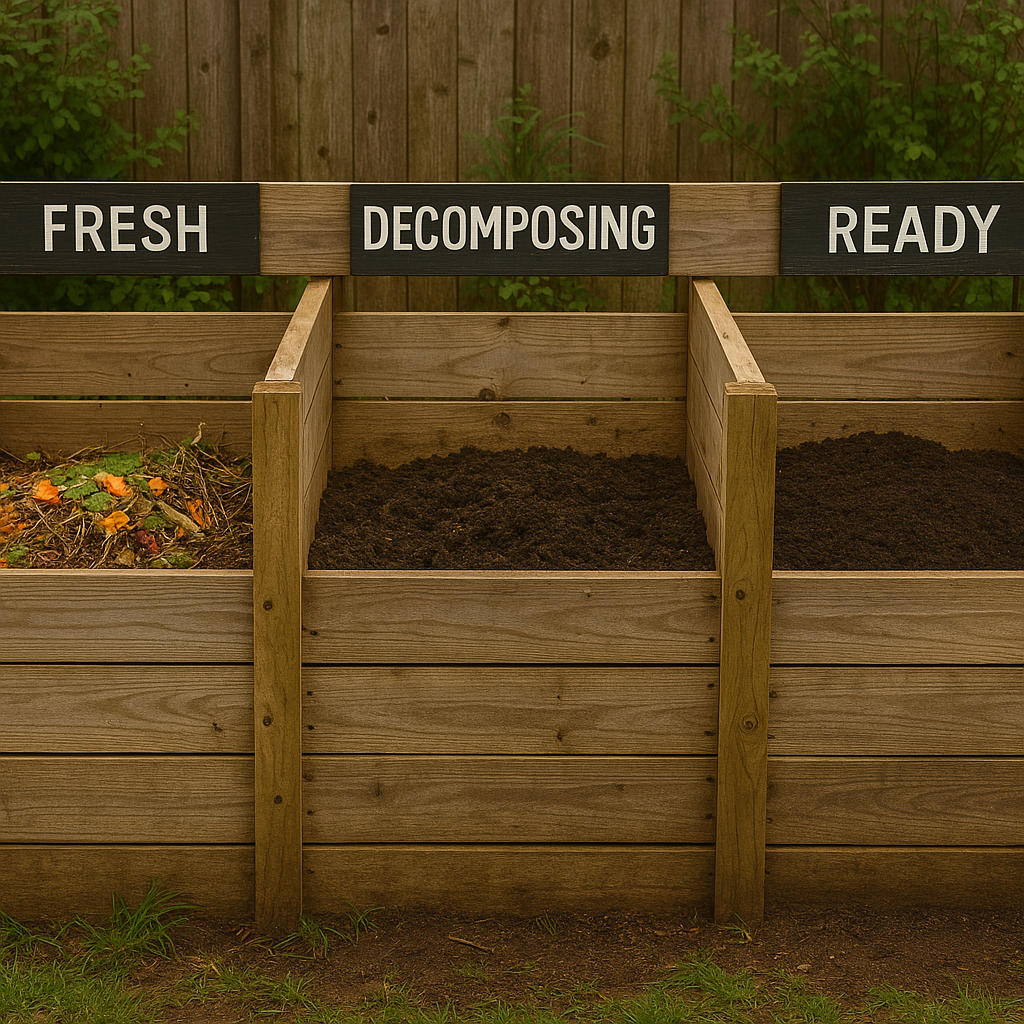
Managing Pests and Odors in a Mixed-Use Space
Keeping Smells at Bay
One of the most common concerns with urban livestock is managing odors. Proper planning and maintenance can keep your backyard homestead smelling fresh and neighbor-friendly.
- Bedding Matters: Use absorbent materials like straw or wood shavings to soak up moisture and reduce odors. Change bedding regularly to maintain cleanliness.
- Composting Manure: Keep manure compost piles well-aerated to minimize the risk of anaerobic decomposition, which produces foul smells.
- Herb Planting: Strategically plant aromatic herbs like lavender, mint, and rosemary near livestock areas to naturally mask odors.
Pro Tip: Create a simple odor-control spray by mixing vinegar and water. Mist livestock areas periodically to neutralize unpleasant smells.
Natural Pest Control Methods
Integrating livestock can actually help manage garden pests if done right. Chickens and ducks are particularly effective at controlling insects and slugs.
- Poultry Patrol: Allow chickens to forage in controlled areas to reduce populations of slugs, beetles, and other pests.
- Duck Duty: Ducks are excellent at keeping slug populations down without scratching the soil as much as chickens.
- Integrated Pest Management (IPM): Rotate livestock grazing areas to disrupt pest breeding cycles and maintain plant health.
Preventing Livestock Pests:
- Coop Cleanliness: Regularly clean coops and remove waste to prevent flies and mites.
- Diatomaceous Earth: Sprinkle food-grade diatomaceous earth around animal areas to control mites and lice naturally.
- Nesting Box Maintenance: Clean out nesting boxes frequently to reduce the risk of parasites.
Real-Life Success Stories: Blending Animals and Gardens
Case Study 1: Backyard Chickens and Raised Beds
Meet Sarah, an urban gardener from Portland who wanted to raise chickens without sacrificing her vegetable garden. Initially, Sarah was hesitant to introduce poultry into her well-maintained garden, fearing damage to her delicate crops. However, with careful planning and thoughtful design, she successfully combined her passion for gardening with backyard chicken keeping.
Sarah designed a small, fenced-off chicken run adjacent to her raised garden beds. The beds were built higher than usual, about two feet off the ground, ensuring that the chickens couldn’t easily hop up and start pecking. To further reinforce the separation, Sarah added wire mesh around the edges, allowing the chickens to see the plants without accessing them. This setup kept her hens from scratching up her plants while still letting them forage in designated areas.
To keep the chickens stimulated and prevent boredom, Sarah incorporated small mobile grazing plots using chicken tractors. She rotates the chickens through these plots, allowing them to graze without impacting any one area too heavily. This rotation also aids in pest control and soil aeration, as the chickens naturally till the ground while foraging. Sarah has found that the dual benefits of eggs and pest management outweigh the effort of maintaining the system.
Key Takeaways:
- Utilize raised beds to protect delicate plants from livestock.
- Designate chicken run areas with secure boundaries to minimize plant damage.
- Rotate grazing plots to maximize pest control without degrading garden spaces.
- Implement mobile grazing areas to prevent overgrazing and maintain soil health.
Case Study 2: A Permaculture Rabbit System
David from Seattle had always been passionate about sustainable gardening. When he decided to add rabbits to his urban garden, his primary goal was to create a closed-loop permaculture system. David designed a multi-level hutch that not only housed his rabbits comfortably but also made manure collection a breeze. The hutch featured a pull-out tray that caught droppings, which David then transferred directly to his compost system.
The rabbit manure, rich in nitrogen, is composted alongside garden clippings and kitchen scraps, creating a balanced, nutrient-dense soil amendment. David discovered that when combined with carbon-rich materials like straw, the manure decomposed faster and with minimal odor. By the end of the season, the compost pile was ready to be spread across his garden beds, enriching the soil and boosting plant growth.
David also strategically planted forage crops like clover and alfalfa around the rabbit hutch. This not only provided a cost-effective feed source but also helped maintain ground cover, reducing soil erosion. The rabbits happily grazed on the forage, contributing to a low-maintenance feeding system. David’s innovative approach to integrating livestock into his garden has inspired other urban gardeners in his community.
Key Takeaways:
- Set up a composting system specifically designed for rabbit manure to maximize nutrient recovery.
- Plant forage crops that serve dual purposes—feeding rabbits and enriching the soil.
- Choose a multi-level hutch design to optimize space and simplify manure collection.
- Incorporate natural ground cover to reduce maintenance and provide consistent forage.
Potential Challenges and How to Overcome Them
Balancing Animal Needs with Plant Protection
Integrating small livestock into an urban garden isn’t without challenges. One of the most significant issues is balancing the needs of the animals with the health and safety of your plants. Chickens, for instance, can be relentless scratchers, while rabbits might nibble on tender greens if given the chance.
Strategies to Minimize Damage:
- Zoning: Clearly define animal and plant areas using fencing, trellises, or raised beds.
- Protective Barriers: Install lightweight, movable barriers around vulnerable crops, particularly during peak growing seasons.
- Animal Rotation: Rotate animals through different areas to prevent overgrazing and give plants time to recover.
- Companion Planting: Plant resilient ground covers like clover to withstand light grazing.
Dealing with Neighborhood Concerns
Urban homesteaders often face neighbor complaints related to noise, odors, or perceived hygiene issues. Being proactive about these concerns helps maintain good relations and community support.
Tips for Being a Good Neighbor:
- Keep It Clean: Regularly clean coops and animal areas to minimize smells and pests.
- Noise Management: Choose quieter animals (like rabbits over roosters) if noise is an issue.
- Attractive Enclosures: Build aesthetically pleasing animal housing to reduce visual impact.
- Community Engagement: Share fresh eggs or garden produce with neighbors to foster goodwill.
Navigating Legal Regulations
Before integrating small livestock, check local regulations regarding backyard animals. Many cities have specific rules about the number and types of animals allowed, as well as housing requirements.
Key Considerations:
- Permits and Licenses: Some areas require permits for keeping livestock.
- Zoning Laws: Confirm that your property is zoned for animal husbandry.
- Animal Welfare Laws: Follow guidelines on space, shelter, and hygiene to meet local animal welfare standards.
- Noise and Nuisance Ordinances: Be mindful of rules regarding noise levels and animal waste management.
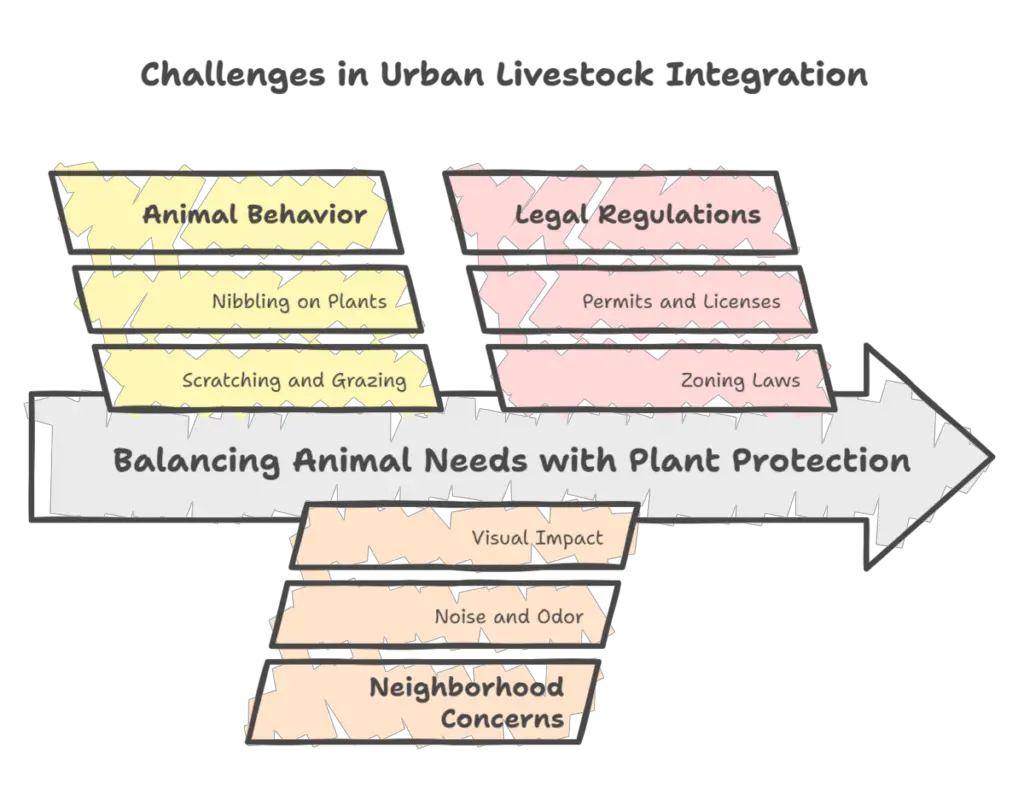
Final Thoughts: Finding Balance in Your Urban Homestead
Successfully integrating small livestock into your urban garden is all about finding the right balance between your animals’ needs and your garden’s productivity. It may take some trial and error, but with thoughtful planning, you can create a harmonious space where plants and animals coexist, thrive, and even support each other.
One of the biggest challenges is adapting your garden layout to accommodate both plant growth and animal activities. Start by experimenting with different configurations and observing how your animals interact with the space. For example, you might find that chickens prefer shaded areas, while rabbits thrive in spots with ample forage. Tailoring your setup to suit these preferences can make a significant difference in maintaining harmony.
It’s also essential to remain flexible and willing to make adjustments. Perhaps you initially underestimated the impact of scratching chickens on your flower beds or discovered that ducks are more prone to digging in wet soil than expected. Instead of seeing these situations as setbacks, treat them as learning opportunities. Modify your barriers, rotate your grazing areas more frequently, or introduce ground covers that can withstand light grazing. By approaching challenges with a problem-solving mindset, you not only improve your garden’s resilience but also deepen your understanding of your livestock’s behavior.
Whether you’re keeping chickens for eggs, rabbits for manure, or ducks for pest control, the key is to remain adaptable and responsive to challenges. Start small, learn from your setup, and gradually expand as you gain confidence. Building a resilient urban homestead means being willing to make adjustments, but the rewards—a productive garden, happy animals, and a more sustainable lifestyle—are well worth the effort.
Another crucial aspect of successful integration is community engagement. Share your successes and challenges with fellow urban gardeners or local homesteading groups. Networking with like-minded individuals can provide fresh ideas, practical advice, and encouragement when you encounter obstacles. Sometimes, just hearing how others manage similar issues can spark creative solutions of your own.
By embracing a thoughtful approach to livestock integration, you’re not just gardening—you’re creating a living, breathing ecosystem that enriches your life and your community. This holistic method not only fosters sustainability but also cultivates a deeper connection between you, your animals, and the land you nurture. The end result is an urban homestead that thrives through balance, bringing a sense of fulfillment and pride from creating a harmonious space where both plants and animals flourish. innovation, and a commitment to harmonious coexistence.
Frequently Asked Questions (FAQ)
1. Can I keep chickens and still maintain a vegetable garden?
Yes, with proper planning and separation, chickens can coexist with your garden. Use raised beds, fencing, and mobile coops to protect plants while allowing chickens to forage in designated areas.
2. What are the best small livestock options for urban gardens?
Chickens, rabbits, and ducks are popular choices. Chickens provide eggs and pest control, rabbits offer nutrient-rich manure, and ducks help with slug and insect management.
3. How do I protect my plants from livestock damage?
Use natural barriers like raised beds, low fences, and ground cover plants that tolerate light grazing. Mobile coops also help control where animals roam.
4. Are there any legal considerations for keeping livestock in urban areas?
Yes, check your local zoning laws and regulations regarding small livestock. Some areas may have restrictions on noise, the number of animals, or waste management.
5. What should I feed my small livestock from the garden?
Leafy greens, vegetable scraps, and designated forage crops like clover and alfalfa are great choices. Be mindful of toxic plants and research safe feeding options for each animal.
6. How can I manage manure effectively in a small garden?
Composting animal waste with carbon-rich materials like straw can create nutrient-dense compost. Ensure proper aeration and curing to reduce odor and pathogens.

